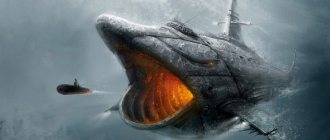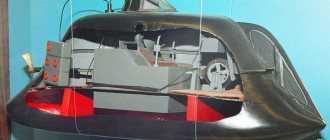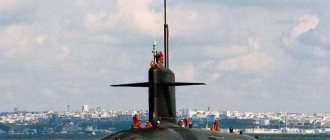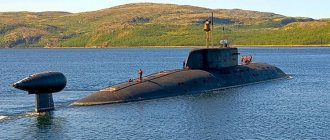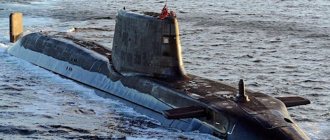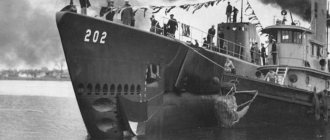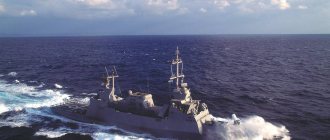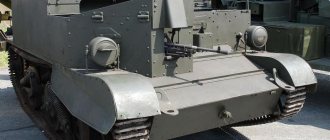Stories of Russian submarine forces
Throughout its life, Russia has been a military power, so it is not surprising that the government decided to keep up with the whole world and enlisted the first submarine vessel in its fleet in 1903, which laid the foundation for the submarine fleet.
First submarine projects
“Dolphin” is considered the first full-fledged submarine of the largest country in the world; before it there was also “Peter Koshka”, but it was very small and served only as a small vessel for covert penetration into enemy territory and reconnaissance landings. In 1904, the first Russian submarine was completed, and in May of this year it was already at sea. She underwent all checks in the Baltic Sea, after which she was transported by rail to Vladivostok, where she was called up for hostilities between Japan and Russia.
Peter Koshka 1901
Lieutenant M.N. Beklemishev was a senior assistant in electrical engineering, and in 1901 he was sent on a business trip to the United States, where he was present at the first test dive of the Fulton submarine, and he was also allowed to inspect a foreign ship. After this trip, the lieutenant stated that the domestic ship was not inferior in quality to the American ones, and several design solutions were completely unique. The trip also gave Beklemishev guidance for gathering a team for the Dolphin; Russia’s first submarine consisted of a crew of 10 people, including one commander and his assistant, 4 mine specialists, as well as two helmsmen and drivers. Each submarine employee was a volunteer, from whom the chief mate selected.
All technical characteristics of the submarine of the Russian Empire, of course, were not at the level of modern vessels:
- Surface/submerged speed: 9/6 knots
- Dive level: 50 meters
- Displacement surface/underwater: 113/up to 135 tons
- Length/width: 20/3.66 meters
- It was armed with two torpedoes of 1898
At first, the designers wanted to install a diesel engine, but then the commission decided to opt for gasoline.
During the war, the “Dolphin” sailed for 17 days across the expanses of the sea, and also went on a campaign for 8 days. In 1916 he was sent north again to Murmansk, and the following year, in August, he was expelled from the fleet, and in 1920 he was scrapped.
The main merit of the ship was not military at all, but the fact that it gave a start to the entire underwater shipbuilding industry and served as a prototype for future submarines.
Table 4
*Built in three sub-series. A larger series of nuclear submarines of 77 units was implemented only during the construction of domestic missile carriers, which, although different in TTX, are based on the same project 667A. ** Construction of the series is not completed.
Submarines, time intervals are indicated by the timing of the laying of the lead submarine and the commissioning of the last in the series of submarines.
The level of development of ALL reached by the mid-90s is characterized by those given in table. 5 data for three American nuclear submarines in recent years of construction.
Russia's first diesel submarine
After the Russo-Japanese War, the state announced its decision to develop a branch of submarine vessels and sent two projects for development. The first one is “Shark”, and the second diesel one is “Lamprey”.
The construction of one of the first diesel submarines in the world was entrusted to I. G. Bubnov, who was the chief designer of the Dolphin. The name of the submarine was given - “Lamprey”, it was developed in 1905, and from 1906 to 1909 its construction was carried out. Despite the fact that the ship was tested in 1908 and launched at the same time, the submarine was sent for revision due to the requirement to increase ballast.
Lamprey 1906
The tragic sinking of the Lamprey
On March 23, 1913, the submarine was making a test dive into water; during the tests, an emergency situation arose; water began to flow through the ventilation valve. Immediately after the rescue operation, it was discovered that all the sailors and command staff had survived, but many had suffered from chlorine poisoning. After which the ship was further used in combat operations.
"Lamprey" was a boat that took part in the First World War. She did not achieve much success, despite some attempts to attack enemy ships. And in 1915, she could have completely sunk from a ram, but due to the outstanding actions of Sergeant Major G.M. Trusov, she survived, and after repairs in 1918 she still served in the civil war in the Caspian Sea.
Russian diesel submarines had predominantly an engine that ran not only on diesel, but also on electricity, which helped them move underwater almost silently.
Table 5
* Improved modification, the lead nuclear submarine of the third subseries.
** According to other sources - 2×30000 hp.
In relation to nuclear submarines (sometimes also to nuclear submarines), the rather conventional but widespread concept of “generation” is used. The signs by which nuclear submarines are classified as belonging to a particular generation are: proximity in time of creation, commonality of technical solutions incorporated in the projects, the same type of power plants and other equipment for general ship purposes, the same hull material, etc. One generation can be classified as nuclear submarines for various purposes and even several successive series. The transition from one series of submarines to another, and even more so the transition from generation to generation, is preceded by comprehensive research in order to justify the selection of optimal combinations of the main tactical and technical characteristics of new nuclear submarines.
Rice. 11. The newest Russian multi-purpose nuclear submarine of the Bars type (project 971)
The relevance of this kind of research has especially increased with the advent of the possibility (thanks to the development of technology) of creating nuclear submarines that differ significantly in speed, immersion depth, stealth indicators, displacement, armament composition, etc. The implementation of these studies sometimes continues for several years and includes the development and military-economic assessment for a wide range of alternative nuclear submarine options - from an improved modification of a serially built nuclear submarine to a variant that is a synthesis of fundamentally new technical solutions in the field of architecture, energy, weapons, hull materials, etc.
As a rule, these studies are not limited only to the design of nuclear submarine variants, but also include entire programs of research and development work in hydrodynamics, strength, hydroacoustics and other areas, and in some cases, discussed above, also the creation of special experimental nuclear submarines.
In countries that build nuclear submarines most intensively, three or four generations of these ships have been created. For example, in the United States, among multi-purpose nuclear submarines, generation 1 usually includes nuclear submarines of the Skate and Skipjack types, generation 2 - Thresher and Sturgeon, generation 3 - LosAngeles. The Seawolf nuclear submarine is considered as a representative of a new, fourth generation of US Navy nuclear submarines. Among the missile carriers, the first generation includes the boats “George Washington” and “Ethan Allen”, the second - “Lafayette” and “Benjamin Franklin”, the third - “Ohio”.
Rice. 12. Modern Russian nuclear submarine missile carrier "Akula" type (project 941)
In total, by the end of the 90s, about 500 nuclear submarines were built in the world (including those disabled due to obsolescence and lost). The number of nuclear submarines by year in the navies and navies of different countries is given in table. 6.
World War I
The First World War was a special war for the submarine fleet. This was the first major military conflict in which different countries were going to use submarines as a new type of weapon. This reality forced us to organize two international conferences. They took place in The Hague in 1899 and 1907. One of the main theses was that no submarine could attack a merchant ship, as this was contrary to international law. In general, no participating state knew exactly how to use submarines in war. Due to the small development of this military segment, many prominent military officials, also the chief designer and leader of submarine shipbuilding: I.G. Bubnov noted that the use of submarines will be mostly coastal and will simply begin to deliver mines over a short distance. At that time, no one even knew that submarines would become powerful weapons not only near the shore, but also on the open sea.
"Shark" on the hunt
"Shark" 1915
During the First World War, Russia had a large number of submarines on its side, but most of them could not go far and cause catastrophic harm to their opponents. You can highlight the submarine "Shark". In 1905, it was designed and it was decided to equip it with a gasoline engine with a capacity of 600 horsepower. After some time, I. G. Bubnov decided to challenge this decision and suggested that the use of gasoline was too flammable and there was a need to replace it with diesel. The Marine Technical Committee accepted his proposals, but the problem remained with the submarine's reduced speed. This happened due to a change in fuel, so the wooden lining was removed from the “Shark”, and the width was also reduced. After this, construction began and in 1909 she was launched. But it was ready for use only in 1911, this was due to all the tests and inspections. She was armed with four devices, as well as two machine guns. However, the boat failed to achieve its designed speed and was entered into the fleet with unjustified expectations. During the entire war, the Akula was considered the best submarine in the country and took part in 16 campaigns and also laid minefields. In November 1915, the boat was sunk; it exploded at the exit from the Gulf of Finland on a drifting mine. At the moment, that's where she is.
Carrier Hunters
Nuclear submarines carrying cruise missiles were built in Gorky according to Project 670 (code “Skat”), developed at SKB-112 (now TsKB Lazurit) under the leadership of chief designer Vladimir Vorobyov. In addition to torpedoes, the Skat weapons were the Amethyst underwater-launched cruise missiles, developed at OKB-52 (general designer Vladimir Chelomei). The missile's flight range at transonic speed was 80 km. The missile could be equipped with either a conventional charge or a nuclear one with a capacity of 200 kilotons. 8 missiles were placed in outboard launch containers, located four on both sides in the bow of the boat, which is why the nuclear submarine in its outline resembled a giant sperm whale. 11 boats were built for the Northern and Pacific fleets. One of them, the “Far Eastern” K-429, turned out to be a failure. On June 24, 1983, she went to sea after scheduled repairs and sank on her first dive, saving Kamchatka at a depth of only 39 m. 16 sailors died. The cause of the accident turned out to be an error when connecting devices during repairs. The nuclear submarine was raised, its restoration cost 300 million rubles and was completed in September 1985. However, on September 13, the loser sank right next to the wall of the plant. The reason was the “human factor” (or simply sloppiness). After that, they decided not to release the submarine, which sank twice, into the sea and turned it into a training station. In the period 1974-1981, Krasnoye Sormovo transferred to the Navy 6 nuclear submarines built according to the modernized 670M project. The difference between the new nuclear submarines was the strengthening of their “main caliber”: the Amethysts were replaced by Malachite missiles. The missiles launched from the same launch containers had a sonic speed and a flight range of 150 km. The submarine also received new hydroacoustics capable of detecting targets at a range of 150 km, making it possible to use missiles at full range without external target designation. The Paravan towed antenna allowed the boat to receive radio signals at a depth of up to 150 m.
The Second World War
Even during the First World War, Soviet troops were the most experienced of all participants in terms of submarines. In the last bloodiest war, not only combat skills were improved, but also the submarines themselves.
A total of 324 submarines were used. And they were all of the following types:
- D – “Decembrist”
- L - "Leninets"
- Ш – “Pike”
- P - "Truth"
- M - “Baby”
- C - “Average”
- K - “Cruising”
The last 3 types will be discussed in more detail.
"Baby"
The submarine received its name due to all the characteristics it possessed, which is exactly what the people themselves called it.
In terms of their displacement, these submarines were 206 tons above water and 258 tons under water. In free navigation, “Malyutka” could surf the depths for 10 days, which was not enough for trips to the open sea. And the maximum depth was 60 meters, but as a rule the ship operated at a distance of 50 meters under the water column. The speed was also not great; under water it accelerated only to 8 knots. The armament consisted of a semi-automatic machine and two torpedo tubes with only two torpedoes of ammunition.
These were small submarines of the USSR, it was their tiny size and light weight that caused the greatest discomfort, the waves scattered the ship in different directions, and the crew found it difficult to endure all the hardships of underwater life. But despite this, the boat still completed a titanic amount of work, sinking 10 enemy ships and damaging 8 vehicles.
"Average"
This type, of course, was larger than the “Malyutka”. The surface displacement reached 840 tons, and under water, of course, this figure was greater and amounted to 1070 tons. The number of crew varied from 36 to 46 members, and the submarines were armed to the teeth. 6 torpedo tubes with 6 torpedoes, also two cannons and a demolition device, and its speed made it possible not to worry about chasing the enemy, the “Medium” accelerated to 20 knots, catching up with almost any opponent.
An interesting story was associated with one of the submarines, which describes the strength, and possibly luck, of this type, which served in the north. About 1000 bombs were dropped on the S-101, but after each of its trips the submarine returned to the city of Polyarny.
"Cruising"
11 representatives of this type were built. The displacement is the largest of all three described types, surface - 1500, and underwater - 2100 tons. Crew from 62 to 65 people. The team could work at a depth of 100 meters. 10 torpedo tubes, and the ammunition load was 24 torpedoes, 2 universal guns and 2 anti-aircraft semi-automatic guns were also present.
This type was popularly nicknamed “Katyusha”, and had truly impressive power; its two diesel engines produced 4,200 horsepower, and its length was 97 meters.
Studying the characteristics, you can see that this is a real thunderstorm for all aquatic inhabitants. But nevertheless, its effectiveness left much to be desired. She has only 5 successful attacks, which is not comparable even to “Baby”. The fact is that the boat was used in shallow waters in the Baltic Sea when service in the Pacific Ocean was planned. It simply did not fit at such a small depth.
The underwater component of the nuclear triad
Naturally, the Soviet Union could not remain indifferent when the US Navy began to commission one after another nuclear submarine of the George Washington series, each of which carried 16 solid-fuel underwater-launched ballistic missiles equipped with nuclear warheads. The decision was made: “to catch up and, if possible, overtake” their overseas “colleagues.” Work on the creation of nuclear submarines that carry ballistic missiles, which they decided to concentrate at TsKB-18 (now TsKBMT Rubin), was headed by the general designer, future academician Sergei Kovalev. At first, the Project 667A nuclear submarine (code “Navaga”) was supposed to carry 8 missiles in rotating (from horizontal traveling to vertical firing position) launchers developed by Leningrad TsKB-34 (now KBSM). But the project failed miserably during the report and demonstration of the layout to Khrushchev. Then, without further ado, they followed the path of the Americans: on the nuclear submarine, behind the wheelhouse fence, 16 vertical missile silos with R-27 liquid-propellant ballistic missiles, created in SKB-385 under the leadership of general designer Viktor Makeev, were placed in two rows. The missile, with a diameter of 1.5 m and a length of about 10 m, carried a nuclear warhead with a yield of 1 megaton (50 Hiroshima). Firing range - up to 2500 km. In addition, the nuclear submarine was armed with torpedoes. Project 667A boats were equipped with Strela portable anti-aircraft missiles to protect nuclear submarines on the surface. The total displacement of the boat was 11,500 tons. The main power plant of the ship had a capacity of 52,000 hp. consisted of two autonomous units, each driving its own propeller. The nuclear submarine had a pop-up antenna to receive target indications from Earth satellites at a depth of up to 50 m. The construction of a series of boats was carried out in Severodvinsk (22 nuclear submarines were built) and Komsomolsk-on-Amur (9 nuclear submarines). The boats were intensively used in the Northern and Pacific fleets. In 1972, the nuclear submarine K-415 made the transition to Kamchatka under Arctic ice. In May 1974, the author of the article, who was on a floating base in Krasheninnikov Bay, had a chance to see one of the Project 667A nuclear submarines return to base, whose sheets of rubber coating on the hull seemed to stand on end. This was explained by its recent collision on transverse courses with the American nuclear submarine Pintado. On October 3, 1986, a fire occurred on board the nuclear submarine K-219, which was on combat duty off the coast of the United States, due to a leak of rocket fuel in one of the silos. As a result, despite the desperate struggle for the survivability of the nuclear submarine, it sank at great depths 600 miles from Bermuda. Most of the crew were saved.
Russia's first nuclear submarines
In fact, project 627 “Kit” was represented by only one “Leninsky Komsomol”, and the rest of the representatives were improvements to this submarine and belonged to the subtype - 627 A. “Leninsky Komsomol” was first called K3. And it was she who opened the era of nuclear submarines for the communist country. This was already the third submarine in the world powered by a nuclear reactor. Its maximum speed was 30 knots, and its endurance was increased to 60 days, thanks to a new type of engine. V.N. Peregudov opened the era of nuclear boats, being the chief designer of the K-3.
Service history
In 1961, she was transferred to the Atlantic for service, and later in 1962, the submarine made history by crossing the North Pole, twice, which was a completely new achievement for the Soviet Navy. The Union flag was also raised for the operation, after which the crew commanders were awarded medals.
Whale
USSR nuclear submarines were built reliably and with a long service life, but the K-3 was an exception. It was erected in a hurry, turning a blind eye to unfinished parts. The reason why this particular submarine was sent to such an important operation was its significance and the experience of the crew, which could maintain the performance of the Lenin Komsomol.
First incident
The crew was not always able to control all unpredictable processes; this happened this time too, when the first two compartments of the submarine caught fire. The main version is that hydraulic fluid leaked and got on the electric lamp, which was not protected by a cap. After this, 39 people died, but nevertheless the boat itself returned to shore, the former commander L.M. Zhiltsov began working on land, and was replaced by Anatoly Zhukov. Now the submarine is preparing to appear not as a warship, but as a museum; the reactor from the boat was sunk in 2013.
For different purposes
The first multi-purpose nuclear submarine of the second generation was the K-38, built at the Admiralty Plant under Project 671 (code “Ruff”). The project was developed by SKB-143 (now SPMBM Malachite) under the leadership of chief designer Georgy Chernyshev. The main power plant of the boat has a capacity of 31,000 hp. consisted of two autonomous steam generating units based on nuclear reactors. The nuclear submarine was equipped with the latest hydroacoustics, navigation and automatic control systems for the boat, its weapons and all general ship systems. In total, Leningrad shipbuilders handed over 16 boats of this project to the fleet until 1975, three of which served in the ranks of the Pacific Fleet. One of them (K-314) was responsible for an incident in the Sea of Japan in March 1984. While tracking the US aircraft carrier Kitty Hawk, the submarine ended up directly under its bottom, which was thoroughly torn apart during the ascent, losing its own propeller. Both parties to the conflict were sent for repairs. In 1989, K-314 was withdrawn from the Navy. The remaining ships of this type completed service in 1993-1996. In parallel with them, boats of the modernized Project 671RT served, armed, in addition to conventional torpedoes, with Vyuga missile-torpedoes, fired from a depth of up to 60 m and capable of hitting any ships and coastal targets with a nuclear charge from a distance of up to 40 km. The Navy received 7 such boats. A further development of multi-purpose nuclear submarines was their modernization under Project 671R). The boat received a stern sonar system with a towed antenna, which was also reflected in its appearance: the appearance of a “bulb” at the stern - the antenna’s container. In addition to torpedoes and missile torpedoes, the nuclear submarine received the Shkval anti-submarine complex with a unique M-5 underwater missile, which reaches speeds of up to 200 knots (more than 350 km/h) at a range of 11 km. The last five 671RTM boats were retrofitted with small-sized Granat cruise missiles with a firing range of up to 3000 km. Nuclear submarine torpedo tubes of 533 and 650 mm caliber had additional functions: laying mines and launching Siren manned sabotage projectiles. In 1975, a folding single-seat Ka-56 helicopter was created for the nuclear submarine, which, together with the pilot, could be fired from a submerged boat like a torpedo. The vaunted James Bond would be jealous of this! A total of 26 boats were built under Project 671PTM. One of them (K-524) in the winter of 1985 made a difficult transition from the Arctic Ocean to the Atlantic around Greenland through narrow, shallow straits full of icebergs. The campaign lasted 80 days, 54 of which were spent under ice.
Modern Russian submarines
Submarines in service with Russia now consist of 70 vessels.
Nuclear submarines of Russia make up a rather impressive part according to statistics, but the fact is that a very large part of them are either under repair or laid up and are not ready for any campaigns, be it a combat sortie or regular patrol.
But nevertheless, the Russians hold many records in the world of submarines, for example, the fastest submarine in Russia reaches speeds of up to 82 km per hour. The maximum diving depth of Russian submarines is also the best in the world. This record was set by Komsomolets, diving to a depth of 1027 kilometers. Russia's secret submarines may be conquering new heights, but alas, this data is not publicly available and perhaps we will learn about it in the future.
As for the future? Russia's newest submarine is already being developed, after the United States presented its Virginia submarine, the Russian power could not stand still, but was forced to also resort to the development of its submarine fleet. The new Russian submarine will be of the fifth generation; by 2030, the government wants to establish regular production of this weapon. This project was also named “Husky”. At the moment, one of the largest boats produced by the largest country in the world is “Yasen”. Many speculated that Russia’s new 5th generation submarines would be superior in size, but this is not the case, despite the huge displacement of 12,000 tons, as declared by the project. "Husky" will not become the largest submarine of the Russian Federation. In general, it is planned to produce this type of submarine in two types. The first will be intended for warfare only under water, and the second for large surface vessels, such as aircraft carriers.
Not just in numbers, but also in quality
No less significant were the qualitative differences between the second generation of nuclear submarines. The diving depth increased from 300 to 400-600 meters, the underwater speed from 18-30 to 26-41 knots. The previous types of weapons were replaced by new ones - more powerful, long-range and accurate. Now the launch of both cruise and ballistic missiles was carried out from nuclear submarines only from under water. In addition to conventional missiles, rocket-torpedoes launched through torpedo tubes were adopted. Integrated automation of all nuclear submarine systems has made it possible to reduce the number of crews. The living conditions of submariners have also noticeably improved, which is especially important given the increasing duration of nuclear submarine voyages. As before, second generation nuclear submarines were divided into three classes: - multi-purpose with torpedo armament; — carriers of anti-ship cruise missiles aimed at combating large enemy ships; - strategic submarine cruisers - carriers of ballistic missiles with nuclear warheads. In November 1967, during the celebrations of the 50th anniversary of Soviet power, the Navy received three first-born nuclear submarines of the second generation of all mentioned classes.
